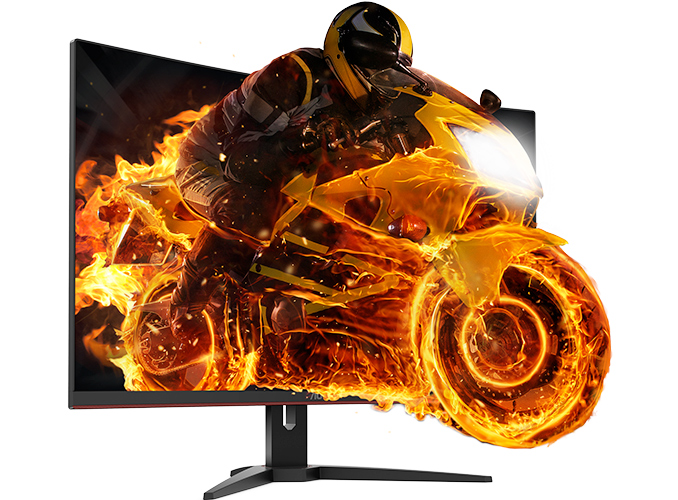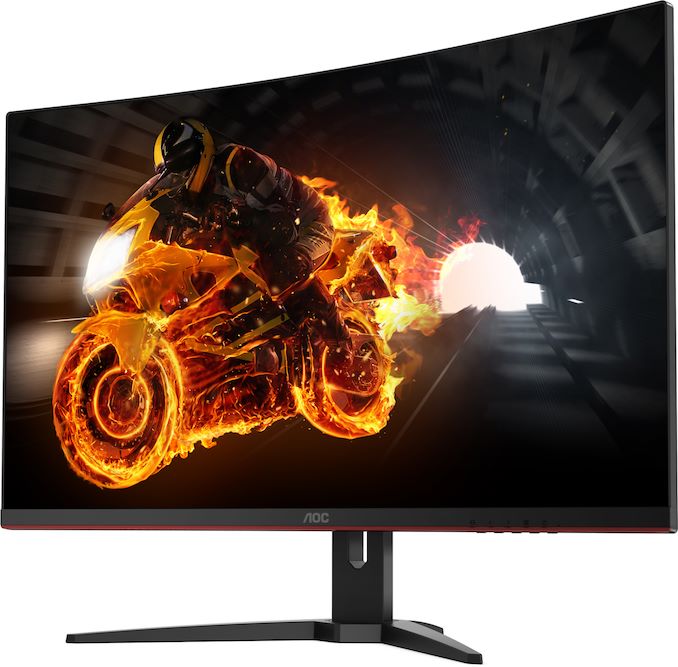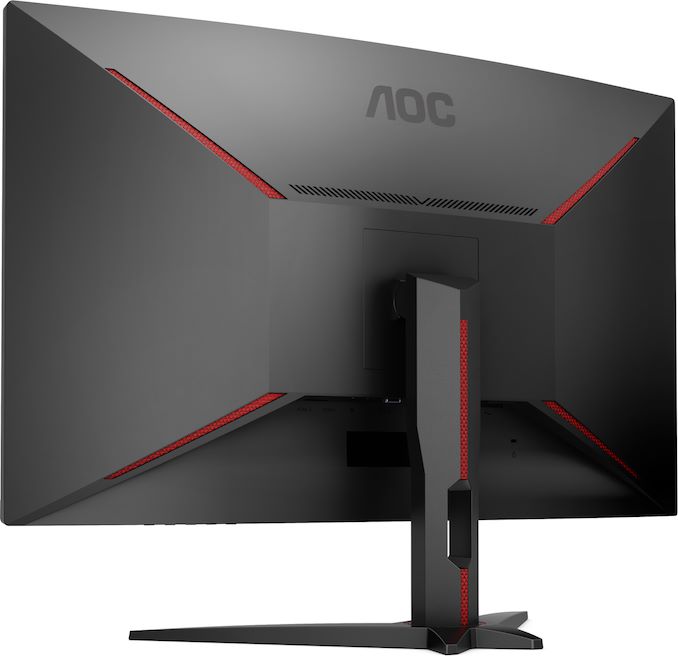AOC’s CQ32G1 Curved Monitor: 31.5 Inch, 144 Hz, FreeSync, Sub $400
by Anton Shilov on February 7, 2019 11:00 AM EST
Last fall AOC introduced its curved G1-series displays aimed at gamers, offering high refresh rates along with AMD’s FreeSync. This month the company has started selling its flagship G1 model, which has a QHD resolution, runs at 144 Hz, supports FreeSync, and has a 31.5 inch size. The CQ32G1 is now available both in Europe and the US at an MSRP below €400/$400.
The AOC CQ32G1 relies on a 31.5-inch curved VA panel of 2560×1440 resolution, 300-nits peak brightness, a 3000:1 contrast ratio, 1 ms MPRT response times, and a 144 Hz refresh rate. The manufacturer says that the panel can display 16.7 million colors and cover 124% of the sRGB color gamut, but does not say whether it can process any other gamuts.
Being primarily a gaming monitor, the CQ32G1 has three key selling points, including 1 ms ultra-low motion picture response time, AMD’s FreeSync dynamic refresh rate technology, as well as a 144 Hz maximum refresh rate. AOC has not disclosed the FreeSync ranges of the display and whether they are wide enough to support AMD’s Low Frame Rate (LFC) features. Entry-level 144 Hz monitors typically feature very decent FreeSync ranges from 30 to 144 Hz and do support the LFC capability.
As for connectivity, like other AOC's G1 displays, the CQ32G1 keeps the number of ports to a minimum. The monitor has a DisplayPort 1.2, two HDMI inputs (1.4 and 2.0), as well as a 3.5-mm headphone jack. To keep BOM costs in check, the manufacturer decided not to equip its G1 monitors with speakers or a USB hub since neither will be truly appreciated by the target audience. For the same reason, AOC outfitted its CQ32G1 LCD has a rather simplistic stand that can only regulate its tilt (-4° ~ +21.5°)
| Specifications of AOC's G1 Series Gaming Displays | |||||
| C24G1 | C27G1 | C32G1 | CQ32G1 | ||
| Panel | 24" VA | 27" VA | 31.5" VA | ||
| Native Resolution | 1920 × 1080 | 2560 × 1440 | |||
| Maximum Refresh Rate | 144 Hz | ||||
| Dynamic Refresh | Tech | AMD FreeSync (LFC is not confirmed) | |||
| Range | 30 - 144 Hz (?) | ||||
| Brightness | 250 cd/m² | 300 cd/m² | |||
| Contrast | 3000:1 | ||||
| Viewing Angles | 178°/178° horizontal/vertical | ||||
| Response Time | 1 ms MPRT | ||||
| Pixel Pitch | 0.27156 mm² | 0.3114 mm² | 0.3637 mm² | 0.2724 mm² | |
| Pixel Density | 90 PPI | 81 PPI | 70 PPI | 93 PPI | |
| Curvature | 1500R | 1800R | |||
| Color Gamut Support | sRGB | ||||
| Inputs | 1 × DisplayPort 1.2 2 × HDMI 1.4 1 × D-Sub |
1 × DisplayPort 1.2 1 × HDMI 1.4 1 × HDMI 2.0 |
|||
| USB Hub | - | - | - | - | |
| Audio | 3.5 mm Headphone Output? | ||||
| Proprietary Enhancements | AOC Flicker Free | ||||
| Power Consumption | Idle | 0.5 W? | |||
| Operating | 20 W | 23 W | 50 W | 37 W | |
| Stand Adjustments | Tilt | -4 ~ +21.5° | -5 ~ +21.5° | -4° ~ +21.5° | |
| Swivel | -34 ~ +34° | - | - | ||
| Height | 130 mm | - | - | - | |
| Pivot | - | - | - | ||
| VESA Mounts | 100 × 100 mm | ||||
| Launch Timeframe | Q4 2018 | September 2018 | Q4 2018 | Q1 2019 | |
| Additional Information | Link | Link | Link | - | |
| MSRP | $230 | $280 | $300 | >$400 | |
The AOC CQ32G1 gaming monitor is now available from leading retailers like Amazon. In the US, the product is available for $395. In mainland Europe the device will cost €399, whereas in the UK it will be priced at £359.
Related Reading:
- AOC Unveils Cheap G1-Series Curved Displays with 144 Hz & FreeSync: Starting at $280
- Sales of High Refresh Gaming Displays Skyrocketing, Curved Gaming LCDs Prevail
- AOC Launches Inexpensive IPS WQHD 31.5-Inch Q3279VWFD8 Gaming LCD with FreeSync
- AOC Expands G90-Series Monitors: 144 Hz and FreeSync
Source: AOC












20 Comments
View All Comments
GreenReaper - Thursday, February 7, 2019 - link
Kinda bizarre that the Full HD version has a lower resolution and brightness, yet is rated at 13 W more (35%) than the QHD one. I guess that extra DSUB port and associated A2D really costs you! Though it's a pity to see it go, as I still have a server that only offers VGA output (up to a high resolution).nathanddrews - Friday, February 8, 2019 - link
I have to ask - why on earth would you connect a curved, high refresh, FreeSync gaming monitor to your server? Or are you just lamenting the passing of the D-Sub15 connection in general? There are still tons of cheap panels out there that have D-Sub15. Most server display drivers only allow for the most basic 60Hz resolutions anyway.A5 - Thursday, February 7, 2019 - link
This is actually something that interests me.VA + Freesync + 1440p is basically what I want in my next monitor, though I wish the density was a bit better.
JoeyJoJo123 - Thursday, February 7, 2019 - link
Same here. The pricing is pretty good, especially given the feature-set and size. I'd easily take a smaller 27" with the same resolution and features for $100 to $50 price reduction.Lately, been thinking that VA is probably the way to go for a future monitor. IPS often suffers from IPS glow and backlight bleed issues (see the PG279Q from Asus that was notoriously bad for backlight bleed issues), but otherwise has good color reproduction, but middling contrast. TN is fine for a main monitor, but suffers when used in multimonitor configs, since the out-of-focus monitors will always look washed out. VA has good enough color, doesn't have the IPS issues, and (beyond getting a partially or fully array backlit model for thousands of $) offers the best contrast ratio, which should generally make most content look more appealing.
Beaver M. - Thursday, February 7, 2019 - link
VA also has glow. A much uglier one. It also tends to flicker.VA is the cheapest of them all. I would rather get a TN panel than VA.
Nagorak - Friday, February 8, 2019 - link
TN panels are by far the worst. No good VA monitor flickers or has any significant glow. If you buy a cheap POS that's a different story.VA also has reasonable black levels which IPS and TN do not. The only major negative about VA is the response time isn't quite as good. Color accuracy also can't match IPS but that generally doesn't matter for gaming.
nathanddrews - Friday, February 8, 2019 - link
"Color accuracy also can't match IPS but that generally doesn't matter for gaming."That's a myth. Nearly every single television rated highest for color gamut coverage and accuracy is a VA panel, not IPS. The few that are not VA are OLED. IPS color accuracy only wins for off-axis viewing - which no one does for a monitor (I hope).
https://www.rtings.com/tv/tests/picture-quality/wi...
The tech is arguably the best current flat panel tech, all things considered. It's just a shame that most PC monitors are of inferior quality compared to their big-screen brethren. Don't blame the tech, blame the implementation.
Nagorak - Friday, February 8, 2019 - link
The contrast ratio on VA monitors really makes all the difference. It's great having actual blacks and not just shimmery dark greys.Valantar - Thursday, February 7, 2019 - link
These panels look interesting, especially considering the price, but curved 16:9 makes no sense to me (34"+ 21:9 panels, on the other hand, really should be curved), nor does 31" 1440p or 27" 1080p. 27" should be 1440p, 31" should be 4k. Period. 81 or 93 dpi? No thanks, though the latter is at least borderline acceptable. 31" 1080p ought to be nice for those with vision impairments (which is great, really, they deserve good monitors too!), but for everyone else that density is abysmal. The "Color gamut support: sRGB" is worrying, though. How much sRGB? 100%? That's decent. If not, how did they manage to make a VA panel with that narrow a gamut?Lord of the Bored - Friday, February 8, 2019 - link
"How much sRGB? 100%? That's decent. If not, how did they manage to make a VA panel with that narrow a gamut?""The manufacturer says that the panel can ... cover 124% of the sRGB color gamut"
Reading: It is pretty much a superpower.